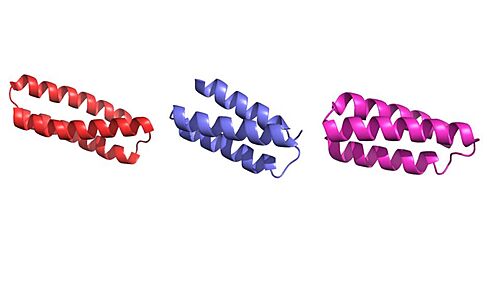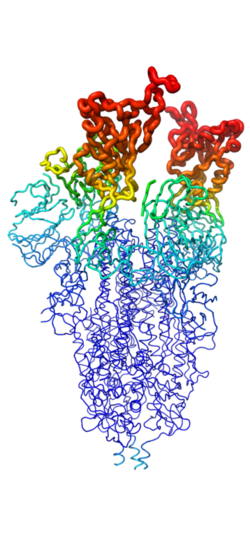Sandbox Reserved 1849
From Proteopedia
(Difference between revisions)
| Line 37: | Line 37: | ||
The goal of designing these minibinders was to create a molecule with a higher binding affinity with the RBD than ACE2, meaning they had to be designed with specific residues that form stronger connections with the same binding pockets that ACE2 would bind to <ref name="Longxing">PMID:32907861</ref>. This section highlights some important residue differences between the minibinders and ACE2 that give the minibinders a higher affinity. | The goal of designing these minibinders was to create a molecule with a higher binding affinity with the RBD than ACE2, meaning they had to be designed with specific residues that form stronger connections with the same binding pockets that ACE2 would bind to <ref name="Longxing">PMID:32907861</ref>. This section highlights some important residue differences between the minibinders and ACE2 that give the minibinders a higher affinity. | ||
| - | The glutamine-493 (Q493) residue is an important residue in showing the differences in strength between ACE2 and the minibinders <ref name="Longxing">PMID:32907861</ref>. ACE2 doesn’t make use of this residue when binding to the RBD, the nearest residues, Glu-35 and Lys-31 <scene name='10/1075250/Q493_ace2/5'>don’t form any interaction with Q493</scene>. Comparing this to the AHB2 minibinder, which forms a Hydrogen bond with the Q493 residue, the AHB2 minibinder makes better use of the RBD’s residue than ACE2, helping it have a higher affinity to the spike protein. LCB1 makes even better use of the Q493 residue, forming two hydrogen bonds with two different residues, giving it the highest affinity based on the Q493 residue. | + | The glutamine-493 (Q493) residue is an important residue in showing the differences in strength between ACE2 and the minibinders <ref name="Longxing">PMID:32907861</ref>. ACE2 doesn’t make use of this residue when binding to the RBD, the nearest residues, Glu-35 and Lys-31 <scene name='10/1075250/Q493_ace2/5'>don’t form any interaction with Q493</scene>. Comparing this to the AHB2 minibinder, which <scene name='10/1075250/Q493-ahb2/3'>forms a Hydrogen bond with the Q493 residue</scene>, the AHB2 minibinder makes better use of the RBD’s residue than ACE2, helping it have a higher affinity to the spike protein. LCB1 makes even better use of the Q493 residue, forming two hydrogen bonds with two different residues, giving it the highest affinity based on the Q493 residue. |
Another important binding site on the RBD includes the Lysine-417 (K417) and Arginine-403 (R403) residues. While ACE2 does form a hydrogen bond interaction with the K417 residue using its own D30 residue, LCB1 forms H bond interactions with both of them, using its own D30 residue, forming a very strong interaction that is hard to break. | Another important binding site on the RBD includes the Lysine-417 (K417) and Arginine-403 (R403) residues. While ACE2 does form a hydrogen bond interaction with the K417 residue using its own D30 residue, LCB1 forms H bond interactions with both of them, using its own D30 residue, forming a very strong interaction that is hard to break. | ||
Revision as of 05:09, 15 April 2025
| This Sandbox is Reserved from March 18 through September 1, 2025 for use in the course CH462 Biochemistry II taught by R. Jeremy Johnson and Mark Macbeth at the Butler University, Indianapolis, USA. This reservation includes Sandbox Reserved 1828 through Sandbox Reserved 1846. |
To get started:
More help: Help:Editing |
SARS-COV2 Minibinders
| |||||||||||
Color Key
■ -> ACE2
■ -> Spike RBD
■ -> AHB2
■ -> LCB1
■ -> LCB3
References
[1] [2] [3] [4] [6] [5] [7] [8] [9]
- ↑ 1.00 1.01 1.02 1.03 1.04 1.05 1.06 1.07 1.08 1.09 1.10 1.11 1.12 1.13 1.14 1.15 1.16 1.17 1.18 1.19 1.20 Cao L, Goreshnik I, Coventry B, Case JB, Miller L, Kozodoy L, Chen RE, Carter L, Walls AC, Park YJ, Strauch EM, Stewart L, Diamond MS, Veesler D, Baker D. De novo design of picomolar SARS-CoV-2 miniprotein inhibitors. Science. 2020 Oct 23;370(6515):426-431. PMID:32907861 doi:10.1126/science.abd9909
- ↑ 2.0 2.1 2.2 2.3 2.4 Case JB, Chen RE, Cao L, Ying B, Winkler ES, Johnson M, Goreshnik I, Pham MN, Shrihari S, Kafai NM, Bailey AL, Xie X, Shi PY, Ravichandran R, Carter L, Stewart L, Baker D, Diamond MS. Ultrapotent miniproteins targeting the SARS-CoV-2 receptor-binding domain protect against infection and disease. Cell Host Microbe. 2021 Jul 14;29(7):1151-1161.e5. PMID:34192518 doi:10.1016/j.chom.2021.06.008
- ↑ 3.0 3.1 Sang P, Chen YQ, Liu MT, Wang YT, Yue T, Li Y, Yin YR, Yang LQ. Electrostatic Interactions Are the Primary Determinant of the Binding Affinity of SARS-CoV-2 Spike RBD to ACE2: A Computational Case Study of Omicron Variants. Int J Mol Sci. 2022 Nov 26;23(23):14796. PMID:36499120 doi:10.3390/ijms232314796
- ↑ 4.00 4.01 4.02 4.03 4.04 4.05 4.06 4.07 4.08 4.09 4.10 4.11 4.12 Huang Y, Yang C, Xu XF, Xu W, Liu SW. Structural and functional properties of SARS-CoV-2 spike protein: potential antivirus drug development for COVID-19. Acta Pharmacol Sin. 2020 Sep;41(9):1141-1149. doi: 10.1038/s41401-020-0485-4., Epub 2020 Aug 3. PMID:32747721 doi:http://dx.doi.org/10.1038/s41401-020-0485-4
- ↑ 5.0 5.1 5.2 5.3 Zhang J, Xiao T, Cai Y, Chen B. Structure of SARS-CoV-2 spike protein. Curr Opin Virol. 2021 Oct;50:173-182. PMID:34534731 doi:10.1016/j.coviro.2021.08.010
- ↑ 6.0 6.1 6.2 Yuan Y, Cao D, Zhang Y, Ma J, Qi J, Wang Q, Lu G, Wu Y, Yan J, Shi Y, Zhang X, Gao GF. Cryo-EM structures of MERS-CoV and SARS-CoV spike glycoproteins reveal the dynamic receptor binding domains. Nat Commun. 2017 Apr 10;8:15092. doi: 10.1038/ncomms15092. PMID:28393837 doi:http://dx.doi.org/10.1038/ncomms15092
- ↑ 7.0 7.1 7.2 Kuba K, Yamaguchi T, Penninger JM. Angiotensin-Converting Enzyme 2 (ACE2) in the Pathogenesis of ARDS in COVID-19. Front Immunol. 2021 Dec 22;12:732690. PMID:35003058 doi:10.3389/fimmu.2021.732690
- ↑ 8.0 8.1 Kuba K, Imai Y, Rao S, Gao H, Guo F, Guan B, Huan Y, Yang P, Zhang Y, Deng W, Bao L, Zhang B, Liu G, Wang Z, Chappell M, Liu Y, Zheng D, Leibbrandt A, Wada T, Slutsky AS, Liu D, Qin C, Jiang C, Penninger JM. A crucial role of angiotensin converting enzyme 2 (ACE2) in SARS coronavirus-induced lung injury. Nat Med. 2005 Aug;11(8):875-9. PMID:16007097 doi:10.1038/nm1267
- ↑ 9.0 9.1 Valetti F, Gilardi G. Improvement of biocatalysts for industrial and environmental purposes by saturation mutagenesis. Biomolecules. 2013 Oct 8;3(4):778-811. PMID:24970191 doi:10.3390/biom3040778


